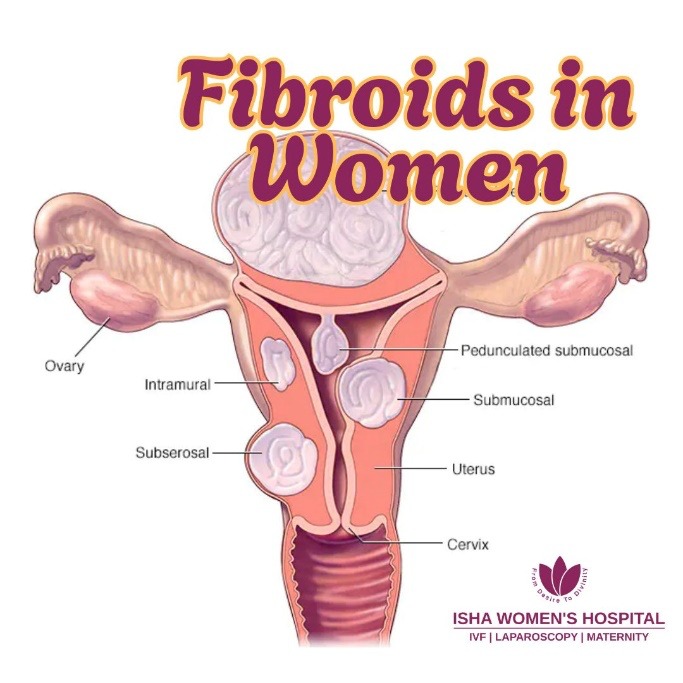Fibroids in Women - Causes, Symptoms and Treatment

Uterine fibroids are noncancerous growths that can silently impact your health, comfort, and even your plans for starting a family. But the good news is—they’re treatable! With advanced diagnostics, personalised care, and minimally invasive treatment options, Dr. Chinmay Pataki and his expert team offer the best in fibroid care, right here in Dombivli.
In this blog, we’ll walk you through everything you need to know about fibroids—what they are,
What Are Uterine Fibroids?
Fibroids are incredibly common, especially among women between the ages of 25 and 50. While some women may never know they have fibroids, others may experience a range of symptoms that can interfere with daily life and even fertility.
Key Features:
- Size: Fibroids can vary dramatically in size. Some are as tiny as a seed or pea, while others can grow as large as a melon, causing the uterus to expand and press against nearby organs.
- Location: Fibroids can develop inside the uterus (endometrium), within the uterine wall (myometrium), or on the outer surface (serosa).
- Nature: They are not cancerous and do not increase the risk of uterine cancer, but they can cause significant discomfort and complications depending on their size and location.
Types of Uterine Fibroids
Here's a closer look at the four main types:
• Intramural Fibroids: These are the most common type of fibroids, growing within the muscular wall of the uterus (the myometrium). They may cause the uterus to appear larger and can lead to heavy menstrual bleeding, pelvic pain, or a feeling of pressure or fullness in the lower abdomen.
• Sub-serosal Fibroids: These fibroids develop on the outer surface of the uterus (serosa). As they grow outward, they can press on nearby organs like the bladder or rectum, leading to urinary frequency, constipation, or back pain. They typically don't affect menstrual flow but can cause discomfort due to their size and position.
• Submucosal Fibroids: Located just beneath the inner lining of the uterus (endometrium), submucosal fibroids protrude into the uterine cavity. Although less common, these fibroids tend to cause the most severe symptoms:
- Heavy or prolonged menstrual bleeding
- Severe cramping
- Difficulty with conception or increased miscarriage risk
• Pedunculated Fibroids: These are fibroids that grow on a small stalk, either inside the uterine cavity or outside the uterus. Depending on their location, they can cause:
- Pelvic pain
- Twisting of the stalk (which may lead to sharp, sudden pain)
- Abnormal bleeding
What Causes Fibroids? Causes, Risk Factors, and Symptoms of Uterine Fibroids
Hormonal Factors
- Estrogen and Progesterone: These hormones stimulate the development of the uterine lining during each menstrual cycle in preparation for pregnancy. Fibroids contain more estrogen and progesterone receptors than normal uterine muscle cells do, suggesting that these hormones promote fibroid growth.
- Family History: Women with a family history of fibroids are more likely to develop them. Specific genetic mutations, such as those in the MED12 gene, have been identified in many fibroids.
Other Risk Factors
- Early Puberty: Beginning menstruation at an early age increases the risk of fibroids.
- Obesity: Excess body weight is associated with a higher risk of fibroids.
- Diet: Consuming a diet high in red meat and low in green vegetables, fruit, and dairy can increase the risk.
- Vitamin D Deficiency: Low levels of vitamin D have been linked to an increased risk of fibroids.
Common Symptoms of Fibroids in Women
- Heavy Menstrual Bleeding
- Can lead to anemia due to excessive blood loss.
- Pelvic Pain or Pressure
- Caused by the size and location of fibroids pressing against pelvic organs.
- Frequent Urination
- Pressure on the bladder can cause a need to urinate more often.
- Constipation
- Fibroids pressing on the rectum can lead to difficulty with bowel movements.
- Lower Back Pain
- Especially if fibroids press on spinal nerves.
- Pain During Sex
- Fibroids can cause discomfort during intercourse, depending on their location.
- Infertility or Miscarriage
- Fibroids can interfere with the implantation of the embryo or the growth of the fetus.
How Are Fibroids Diagnosed?
- Pelvic Examination: A routine pelvic exam can reveal an enlarged or irregularly shaped uterus, suggesting the presence of fibroids. During the exam, the doctor may feel for abnormalities in the uterus's size and shape.
- Ultrasound Imaging: Ultrasound is the most common and non-invasive imaging tool used to confirm the presence of fibroids.
There are two types: - Transabdominal Ultrasound: The probe is moved over the abdomen to capture images.
- Transvaginal Ultrasound: A probe is inserted into the vagina for a closer view of the uterus.
- Magnetic Resonance Imaging (MRI): MRI provides detailed images of fibroids, helping to determine their size, number, and location. It's particularly useful for complex cases or when planning surgical interventions.
- Hysteroscopy: This procedure involves inserting a thin, lighted telescope (hysteroscope) through the cervix into the uterus. The hysteroscope allows direct visualization of the uterine cavity to identify submucosal fibroids.
Treatment Options for Fibroids
- Myomectomy: This procedure involves the surgical removal of fibroids while preserving the uterus, making it an option for women who wish to maintain fertility. Myomectomy can be performed through:
- Hysteroscopy: For fibroids inside the uterine cavity.
- Laparoscopy: Minimally invasive techniques using small incisions.
- Hysterectomy: A hysterectomy is the complete removal of the uterus and is considered when fibroids cause severe symptoms and other treatments have failed, or when childbearing is no longer desired. It can be performed via:
- Abdominal Surgery: Open surgery through a larger incision.
How Fibroids Affect Fertility and Pregnancy
Impact on Fertility
- Embryo Implantation: Submucosal fibroids grow into the uterine cavity, potentially distorting the endometrial lining. This distortion can hinder the implantation of an embryo, reducing the chances of conception.
- Fallopian Tube Blockage: These fibroids can obstruct the fallopian tubes, preventing sperm from reaching the egg or hindering the passage of a fertilized egg to the uterus.
- In Vitro Fertilization (IVF) Challenges: The presence of fibroids can decrease the success rates of IVF by affecting the uterine environment necessary for embryo implantation.
- Miscarriage and Preterm Labor: Fibroids, especially those altering the uterine cavity, are associated with a higher risk of miscarriage and preterm birth.
- Abnormal Fetal Position: Large fibroids can cause the baby to settle in a breech or transverse position, complicating delivery.
- Placental Abruption: In some cases, fibroids can lead to the placenta detaching from the uterine wall before delivery, posing risks to both mother and baby.
- Preconception Treatment: Surgical removal of fibroids, such as through myomectomy, can enhance fertility and reduce pregnancy complications.
- Regular Monitoring: Women with known fibroids should have regular prenatal check-ups to monitor fibroid growth and manage potential complications.
Tips for Managing Fibroids Naturally
Maintain a Healthy Weight
- Hormonal Balance: Excess body fat can increase estrogen levels, which may promote fibroid growth. Achieving and maintaining a healthy weight can help regulate hormone levels.
- Nutrient-Rich Foods: Incorporate plenty of fruits, vegetables, whole grains, and legumes. These foods are high in fibre and can help reduce estrogen levels.
- Limit Red Meat and Processed Foods: Diets high in red meat and processed foods have been linked to an increased risk of fibroids. Opt for lean proteins and minimize processed food intake.
- Hormonal Regulation: Engaging in regular physical activity can help balance hormones and reduce the risk of fibroid development. Aim for at least 30 minutes of moderate exercise most days of the week.
- Vitamin D: Deficiency in vitamin D has been associated with an increased risk of fibroids. Supplementation may help reduce fibroid size.
- Green Tea Extract: Some studies suggest that green tea extract may inhibit fibroid cell growth and reduce symptoms.
If you’re experiencing symptoms of fibroids or have been diagnosed and are unsure about the next steps, know that expert help is within reach. Isha Women’s Hospital, is committed to provide compassionate, state-of-the-art care tailored to your unique needs. Dr. Chinmay Pataki, one of the most trusted gynaecologists and fertility specialists in Thane, brings extensive experience and a patient-first approach to treating uterine fibroids and related reproductive health conditions.
Whether you’re planning for pregnancy, seeking relief from discomfort, or simply want clarity about your condition, Dr. Chinmay Pataki with his expert team is here to guide you with the latest diagnostic tools and both surgical and non-surgical treatment options. Our goal is not just to treat—but to empower you with knowledge and confidence.
Choose Isha Women’s Hospital – where expertise meets empathy, and your health comes first. Book your consultation today and take the first step toward a healthier, fibroid-free future.
Frequently Asked Questions (FAQs)
Ans - No, fibroids are almost always benign (non-cancerous).
2. Can fibroids go away on their own?
Ans - Small fibroids may shrink naturally after menopause.
3. Do fibroids always require surgery?
Ans - No—many fibroids can be managed with medication or non-invasive therapies.
4. Can fibroids cause infertility?
Ans - Yes, especially submucosal fibroids that affect the uterine lining.
5. How are fibroids treated during pregnancy?
Ans - Most are monitored closely unless they cause serious complications.
